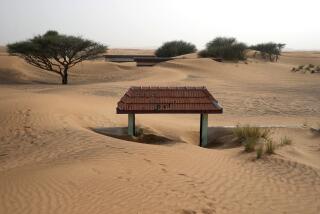The Trail to a Desert Atlantis
- Share via
Mention archeology and, at least for some of us, up pop mental images of the swashbuckling adventures of Indiana Jones. But in fact what an archeologist needs is not derring-do but a lot of erudition and the imagination to see an elegantly painted wall in a jagged heap of bricks or an inspiring statue in a featureless chunk of rock.
Last week a Los Angeles-based team of explorers announced that it had done just that, finding an ancient trade route in the sand, gullies and goat paths of eastern Yemen. The discovery, which some scholars likened to finding the fabled Silk Road to the Orient, was one of several made by a group of Los Angeles filmmakers, lawyers, scholars and scientists, all sharing the kind of drive and imagination long associated with their city.
The team members used every tool from wrenches to a Global Positioning System satellite to navigate their 1985 land cruiser through Grand Canyon-like terrain. But it was imagination that allowed them to see something extraordinary in what most of us would dismiss as common--small stones nestled near large rock pillars. In these arrangements they saw “triliths,” man-made formations that marked the way to Ubar, a center of spice trade at the time of the Roman Empire.
Since 1981, the team members have been exploring the region around Ubar, drawn by an awareness that the city--celebrated by its citizens as “an imitation of Paradise” and scorned in the Koran as a “center of sin”--was perhaps the most mysterious site in ancient Arabia.
Only imagination could put the L.A. team on the trail, for more than a millennium ago some geological event sent Ubar plunging into a giant limestone cavern, making it, as the British explorer T.E. Lawrence once wrote, “the Atlantis of the Sands.”
More to Read
Sign up for The Wild
We’ll help you find the best places to hike, bike and run, as well as the perfect silent spots for meditation and yoga.
You may occasionally receive promotional content from the Los Angeles Times.






